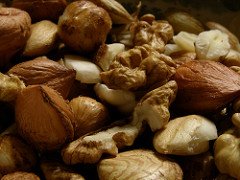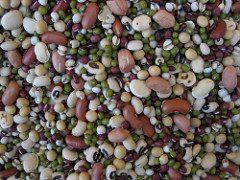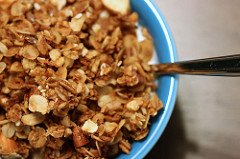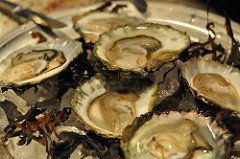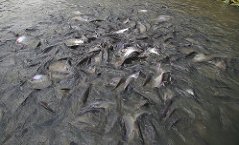Diet and Nutrition
World Health Organization Daily Recommendations1Fruits, vegetables, legumes, nuts, and whole grains with 400+ grams (five portions) of fruits and vegetables a day Fewer than 10 percent total energy (calories) from free sugars Fewer than 30 percent total energy from fats, with a shift in fat consumption away from saturated fats to unsaturated fats and eliminating industrial trans-fats Less than five grams of salt (about one teaspoon), using iodized salt Energy intake each day should correspond to energy expended Specific recommendations during pregnancy are listed on our Pregnancy page. |
Diet is key to health. Globally, an unhealthful diet, together with a lack of physical exercise, is a leading risk factor for poor health, increasing risks for obesity, diabetes, heart disease, stroke, and cancer. Consuming essential nutrients—protein, fiber, minerals, vitamins, and antioxidants—is important to staying healthy for both adults and children. These nutrients are found and best consumed in a variety of foods:2
- Whole grains (not highly processed)
- Fresh fruits and vegetables, but not starchy foods such as potatoes
- Legumes (lentils and beans)
- Nuts

Dietary Fats
Fat is a necessary nutrient. Many body functions rely on a supply of healthy fats, including omega-3 fatty acids such as EPA, DHA, and ALA. These fats are found in many types of seafood, including fatty fish and shellfish, as well as in some vegetable oils such as canola and soy. Moderate evidence has emerged about the health benefits of consuming seafood to reduce risks of heart disease and modestly reduce symptoms of rheumatoid arthritis.
To promote fetal and infant development, the National Center for Complementary and Integrative Health recommends that pregnant or breastfeeding women consume eight to 12 ounces of seafood per week from a variety of seafood types that are low in methylmercury, and that children eat age-appropriate quantities after weaning. The health benefits of omega-3 dietary supplements are unclear.10
Even though fat is essential, too much fat—especially saturated fats found in red meats and trans-fat in processed food—increases the risk for heart disease and stroke. Processed meats usually contain unhealthful amounts of both fats and salt. White meats such as from poultry and fish are lower in fat. Daily fat intake should provide fewer than 30 percent of total calories.11
Vegetable oils including olive, sunflower, corn, and soy have healthful unsaturated fats, while oils high in saturated fats include butter, ghee, lard, coconut, and palm oils. Trans-fats are usually found in processed, baked, and fried foods.15
Micronutrients
Several micronutrients are essential for health, especially during development. We highlight some key ones here.
Iron
Iron is an essential mineral because it is needed to make hemoglobin, a part of blood cells. Iron is also essential for brain and nerve development. Low iron content (anemia) during pregnancy can increase the risk of perinatal death and low birth weight. Globally, roughly 40 percent of all children under five years old and pregnant women have an iron deficiency. A 2009 global report states that iron deficiency anemia during pregnancy is associated with 115,000 deaths each year, accounting for one-fifth of all maternal deaths.16 The best dietary sources of iron:17
-
Dried beans
Dried fruit compote
- Dried fruits
- Eggs (especially egg yolks)
- Iron-fortified cereals
- Liver
- Lean red meat (especially beef)
- Oysters
- Poultry (dark meat)
- Salmon
- Tuna
- Whole grains
Iodine
Iodine is needed for cells to convert food into energy and also for normal thyroid function and the production of thyroid hormones. Iodine is required for fetal brain development, and low iodine may be responsible for mental impairment in 18 million babies annually. For this reason and to prevent goiter, salt is fortified with iodine, which is available in 70 percent of the world. Dietary sources of iodine:18
-
Iodized salt
Cod
- Seafood, especially cod, sea bass, haddock, and perch
- Kelp
- Dairy products
Vitamin A
Vitamin A is known as retinol because it produces pigments in the retina of the eye. Vitamin A promotes good vision, especially in low light, and it may also be needed for reproduction and breastfeeding. Vitamin A is needed in forming and maintaining healthy teeth, skeletal and soft tissue, mucous membranes, and skin.
The developing immune system and eyesight require vitamin A. Children with vitamin A deficiencies suffer from more blindness, measles, and diarrhea than those without. Although it is an essential nutrient, one-third of all young children and one in six pregnant women have deficiencies.19
Two types of vitamin A are found in the diet:
- Preformed vitamin A, found in animal products such as meat, fish, poultry, and dairy foods. Unfortunately, most animal sources of vitamin A are also high in saturated fat and cholesterol.
- Pro-vitamin A is found in plant-based foods. Precursors to vitamin A, the body converts these substances to vitamin A.21
|
|
Beta-carotene is a naturally occurring pro-vitamin A. The richest sources of beta-carotene are yellow, orange, and leafy green fruits and vegetables: carrots, spinach, lettuce, tomatoes, sweet potatoes, broccoli, cantaloupe, and winter squash.22
Zinc
This mineral is important for immune system function and plays a role in cell division, cell growth, wound healing, and the breakdown of carbohydrates. Zinc is also important for the development of the nervous system. Those low in zinc are at a higher risk for premature birth, diarrhea, infections, poor growth, and all-cause mortality. Globally, 17 percent of people have a diet insufficient in zinc. Dietary sources of zinc:23
|
|
- Animal proteins: beef, pork, and lamb contain more zinc than fish, and dark meat of poultry has more zinc than light meat
- Nuts
- Whole grains
- Legumes such as dried beans and lentils
- Yeast
Folate
This vitamin is important for cell growth and to help the body prevent anemia. Folic acid, the synthetic form of folate, is found in supplements and added to fortified foods. Folate is essential during early fetal development, supporting healthy development of the brain, skull, and spinal cord. Foods fortified with folic acid, or folic acid taken as a supplement, can reduce the risk of neural tube defects by up to 50 percent. Folic acid supplements before and during the first trimester can lower chances of miscarriage. Dietary sources of folate or folic acid:24
|
Dried beans |
- Leafy green vegetables
- Fruits
- Dried beans, peas, and nuts
- Enriched breads, cereals, and other grain products
Vitamin D
The body makes this fat-soluble vitamin when exposed to sunlight and converts it into a hormone called activated vitamin D or calcitriol. Vitamin D is essential for calcium absorption, and severe vitamin D deficiency has long been associated with rickets in children and osteomalacia in adults. Both of these conditions cause soft, thin, and brittle bones. More recent findings indicate that vitamin D deficiency appears to interact with incidence and progression of infectious disease—notably tuberculosis and HIV/AIDS—and possibly with immunologic and cardiovascular diseases and cancer.25
Very few foods naturally contain vitamin D, but many are fortified with vitamin D. Dietary sources of vitamin D:
- Fatty fish, such as tuna, salmon, and mackerel
- Beef liver, cheese, and egg yolks provide small amounts
- Mushrooms provide some vitamin D, but only after exposure to ultraviolet light such as sunshine28
- Most milk in the United States is fortified with vitamin D, but not other dairy products such as cheese and ice cream
- Many breakfast cereals and some brands of soy beverages, orange juice, yogurt, and margarine
Sugar
Diets high in added sugar contribute to tooth decay and may increase the risk of weight gain and obesity. Consumption of sugary foods may also reduce the consumption of foods containing the micronutrients needed for health.29
Added sugar comes in many forms, including cane sugar, honey, corn syrup, and other sweeteners. Added sugar is of course found in many pastries, soft drinks, jellies, candy, puddings, ice cream, and other confections. Sugar is also often added to other processed foods that otherwise could be healthful:
|
granola |
- Yogurt
- Peanut butter
- Granola and other whole-grain cereals
- Chocolate
- Fruit smoothies
- Tomato-based sauces
- Fat-free salad dressings
- Processed fruit, such as juices and applesauce
- Whole-grain crackers
Low-sugar or sugarless varieties of these foods are recommended.
Salt
Salt is a necessary nutrient for our bodies, but most people worldwide consume far more than needed—around twice the recommended maximum level of intake on average. Salt is the primary source of sodium worldwide, and increased consumption of sodium is associated with hypertension and increased risk of heart disease and stroke. Salt is added to food both during preparation and at the table. Foods particularly high in salt or sodium:
- Prepared meals and convenience foods
- Processed meats such as bacon, ham, and salami
- Cheese
- Salty snack foods
- Instant noodles
- Soy sauce, fish sauce, and other sauces
Bread and processed cereal products also contain salt, and, because they are consumed frequently in large amounts, can contribute to overconsumption of salt.30
Malnutrition
Barriers to Obtaining Adequate Food31
|
Malnutrition can come either from a lack of food or from a lack of the right kinds of food. Malnutrition comes in two main forms:32
- Protein-energy malnutrition, a lack of protein and calories, is more lethal than other forms of malnutrition and is generally what is meant in references to world hunger. This form of malnutrition can be caused by an unhealthful restriction in protein and calories that can lead to death, wasting, or nutritional edema. An unhealthful restriction in nutrients can also cause stunting in children. A 2016 report estimates that 250 million children (43 percent) younger than five years in low-income and middle-income countries are at risk of not reaching their developmental potential because of extreme poverty and stunting.33
- Micronutrient deficiencies are specific to micronutrients, including those discussed above. Severe micronutrient deficiencies can lead to health conditions including scurvy (vitamin C deficiency), pellagra (niacin or tryptophan deficiency), beriberi (thiamine deficiency), goiter or cretinism/neonatal hypothyroidism (iodine deficiency), and xerophthalmia (vitamin A deficiency).34 Moderate deficiencies can cause impaired cognitive development, excess bleeding, and impaired immune system function leading to disease susceptibility.35
During the 2014-2016 period, globally one in nine people, most of whom were in developing countries, were estimated to suffer from chronic undernutrition.36
Diet and the Microbiome
The human microbiome—the collection of all the microbes found in our body, including bacteria, parasites, fungi, yeast, and viruses—is essential to our health. Research on the microbiome is still very new, and more research needs to be conducted to understand its health impacts. To date, evidence indicates that our individual microbiomes are influenced by what we eat. In fact, much of the variation of gut microbiomes between people is thought to be due to differences in diet.
Many—perhaps most—of these microbes aid in digesting food and fighting illness. The human gut microbiome can be quickly altered by a change in diet, sometimes as fast as within three or four days. These differences can affect which genes are transcribed for the body's production of proteins, potentially impacting how our bodies process food or respond to disease.
Research has found that animal-based diets increase the abundance of bile-tolerant microbes while also decreasing the colonies that digest plant carbohydrates.38 In mice, these differences may account for the association that has been found between meat consumption and an increase in bacteria known to foster inflammatory bowel disease.39
Breastfeeding
Health professionals around the globe recommend exclusively breastfeeding infants from birth to six months of age if possible. Breast milk provides all of the nutrients and fluids an infant needs to fully support health and growth. Containing more than just nutrients and immune protection, breast milk provides information about the environment that new babies are living in, shaping biological features and influencing the development of the immune system, stress response, metabolism and fat deposition, brain development, growth, blood pressure, and reproductive systems. Other impacts on health:41
- Breastfed infants are less likely to experience diarrhea, ear infections, and respiratory infections.
- Breastfed babies have lower risks of necrotizing enterocolitis, infectious diseases, and obesity.
- Adults who were breastfed as infants are less likely to have overweight or obesity or to develop diabetes or heart disease or to have a stroke.
- Mothers who breastfeed have a lower risk of breast cancer.
Contaminants in Breast Milk
One of the most unfortunate outcomes of our exposures to environmental pollutants is the contamination of our breast milk. Persistent organic pollutants (POPs), pesticides, heavy metals, flame retardants, dioxins, and other contaminants have all been documented in human breast milk.42
A 2008 review weighing the risks from such contaminants against the benefits of breast milk concluded that "the WHO, the US Surgeon General, and the American Academy of Pediatrics continue to recommend breastfeeding."43
Food Safety & Packaging
Food Safety
Top Risk Factors for Foodborne Illness44
|
Food safety involves illnesses that arise from eating contaminated food, including foodborne disease and infections. Many contaminants can be found in the foods we eat:45
- Harmful microbial agents (bacteria, worms, fungi, viruses, and toxins)
- Chemical hazards (marine and mushroom toxins, heavy metals, pesticides, preservatives, and additives)
- Residues of medicines from food animals (antibiotics and hormones)
- Foreign objects (bones, shells, glass, metal, stones, plastic, soil, hair)
- Radioactive materials
- Materials used in packaging (plastics, bisphenols, phthalates, PFCs, waxes)
- Other contaminants (insect and rodent debris, cleaning agents)
Bacterial pathogens alone account for many foodborne illnesses, responsible for diseases such as salmonellosis, botulism, staph infections, listeriosis, and E. coli poisoning. Viruses are responsible for diseases like norovirus, while prions (infectious, misfolded proteins) can cause mad cow disease, which has caused illness in small numbers of people.47
Packaging
Food contact materials (FCMs) are the objects that come into contact with food, and include packaging, containers, processing equipment, and preparation equipment. Many of these materials are human-made, including plastics, rubber, paper, and metal.48
Some of these items—can coatings, the lamination in paper containers, and plastic bottles, trays, and wraps—contain chemicals that can leach into the foods they contact. This contact can be a source of food contamination. Researchers have identified these concerns with FCMs:49
|
|
- Acknowledged toxicants are used legally, such as asbestos in rubber products and formaldehyde in plastic bottles. Both these substances are known to cause cancer.
- Some materials contain endocrine disrupting chemicals, such as BPA, tributyltin, triclosan, and phthalates. Health impacts from endocrine disruption include some types of cancer, reproductive harm, obestiy, and nervous system harm, including neurobehavioral disorders, Alzheimer's disease, and psychiatric disturbance. Research on health impacts from specific chemicals is far from complete.
- More than 4000 chemical substances are known to be used as FCMs, with many unknown byproducts and breakdown compounds (metabolites).
Flame retardants are generally fat soluble, capable of leaching from food wrapping and packaging into fat-containing products such as butter and meat. A 2011 study on flame retardants in food wrapping paper found that alarmingly high levels of decaBDE had leached from wrappers into butter products intended for human consumption.50 Flame retardants have been connected to reproductive toxicity, cancer, impaired neurological development, endocrine disruption, and immune disruption.51
Genetically Modified Foods
Genetically modified foods are those in which DNA has been altered through unnatural processes.52 Although humans have been genetically modifying foods through selective breeding for as long as humans have been farming, new technologies enable gene transfers between organisms in ways that are highly unlikely from natural breeding. For example, a Bt gene that provides resistance to a beetle pest is physically conveyed from a bacterium into tomato plants. This gene bestows innate protection against pests to the tomatoes, potentially leading to fewer pesticides used on crops.53
A goal of genetically engineering food sources is to increase the amount and quality of food while requiring less effort and reducing cost. GMO crops currently on the market have been developed for an increased level of resistance against plant diseases caused by insects or viruses or for increased tolerance towards herbicides.54
As of 2016, the United States Department of Agriculture reported that 92 percent of all US acres of corn, 94 percent of all acres of soybeans, and 93 percent of all acres of cotton used genetically modified seeds.55

The substantial increases of GMO crops since the start of the twenty-first century have implications for pesticide use. In the graphs below, the green and red areas combined indicate use of HT (herbicide-tolerant) crops, whose benefit is derived when applying herbicides to crops, while the red and blue areas combined indicate use of Bt (insect-resistant) crops, which could indicate less use of insecticides:
 |
 |
|
Source: US Department of Agriculture56 |
|
The use of herbicide-tolerant crops has the potential to increase the use of herbicides dramatically, as seen with glyphosate at right. A 2016 analysis found that for both soybean and corn (maize), glyphosate-tolerant seed adopters used increasingly more herbicides relative to nonadopters, whereas adopters of insect-resistant corn used increasingly fewer insecticides from 1998 to 2011.58 The increase in herbicide use is a health concern if the herbicides used impact human health. The reduced use of insecticides should reduce exposures of farmworkers, their families, and their communities to these toxic chemicals, and it may reduce residues of these chemicals in water. See our Pesticides page for more information about health effects of pesticides.
The introduction of genetically engineered crops has been controversial. Some opponents claim that the health and environmental impacts of such foods are unknown and that the cross-breeding of GMOs with unmodified crops is uncontrollable. There is very little evidence to date that GMO foods themselves pose any health risk,60 but it's too soon to assess long-term impacts.
US Foods Currently Containing GMOs61
|
Because of varying genetic techniques for modifying plants, the safety and health impacts of genetically modified organisms (GMOs) cannot be assessed collectively but must be assessed on a case-by-case basis. The World Health Organization states that all available GMO products have passed safety assessment and are “not likely to present risk for human health”, nor have human health effects been observed where approved food are in commerce.62
Future direction of GMOs:63
- Improved resistance against disease and drought
- Crops with increased nutrient content
- Fish with enhanced growth characteristics
- Organisms that produce pharmaceuticals or vaccines
Agriculture and Aquaculture
Conventional Farming
Conventional farming, also known as industrial farming, has contributed enormously to the increase in food production over the last half century. Features of conventional farming:64
|
|
- Technological innovation
- Large-scale farms
- Single crop production
- Continuous growing
- Use of high-yield crops
- Extensive use of pesticides, fertilizers, and external energy
- High labor efficiency
- Confined, concentrated livestock production
The philosophy that supports conventional farming views nature as a competitor to be overcome. This perspective raises several concerns regarding the costs of conventional farming on the health of ecosystems:66
- Decline in soil capacity and desertification
- Water pollutants and dead zones
- Water scarcity and the depletion of aquifers
- Pesticide impact on non-target species, including pollinators
- Pest resistance
Specific concerns to human health from conventional farming include pesticide and nitrate contamination in food and water supplies and the use of antibiotics in animal production and the spread of antibiotic resistance.68
Agriculture's Impact on Water Quality
Rain, snowmelt, and irrigation water that isn't absorbed by soil or doesn't evaporate flows across farmlands, ultimately ending up as surface water—creeks, rivers, ponds, lakes, and oceans. This runoff picks up contaminants from soil and other surfaces it traverses and can include pesticides, animal waste, heavy metals, phosphorus, and nitrates. This runoff pollution is the primary source of contamination in lakes and rivers. Water that collects in low areas and eventually percolates down into the soil can also contaminate groundwater.69
Nitrogen-based fertilizers, as well as wastes from animals and humans, decompose within soil and water to form nitrates and nitrites. Globally, the increasing use of artificial fertilizers, the disposal of wastes (particularly from animal farming), and changes in land use are the main factors responsible for the progressive increase in nitrate levels in groundwater supplies since 1990.72
High levels of nitrates in the body, such as when a person becomes dehydrated, can impede oxygen availability in the blood, depriving cells of needed oxygen. Children under four months old are at highest risk from nitrate-related effects, including a potentially lethal condition known as blue baby syndrome. Pregnant women are also at increased risk.74
In 2010, US researchers found that 64 percent of shallow monitoring wells in agricultural areas showed nitrate contamination “too high.”75

Antibiotic Use in Agriculture
Antimicrobial resistance (AMR) occurs when bacteria that cause disease in humans and animals become resistant to antibiotics. The use of antibiotics, especially in conventional farming, may be a significant contributor to antibiotic resistance globally.
Antibiotic use in US agriculture is on the rise, with an increase of 16 percent from 2009 to 2012. In contrast, the Netherlands, Europe's largest livestock producer, reduced the use of antibiotics for livestock by 50 percent during the same period. FDA data indicate that 80 percent of the 30 million pounds of antimicrobials sold in the US each year are given to animals.

97 percent of those antimicrobials for animals are sold without prescription, indicating that they are not necessarily for treatment of disease but may be for disease prevention and growth promotion. Intensive livestock production methods that crowd animals, deprive them of access to nature, divert them from the foods they evolved to eat, and inhibit their natural social interactions necessitate antimicrobials to keep animals healthy and maintain productivity.
In addition to well-founded concerns about the increase of antibiotic-resistant strains of bacteria and the implications for treatment of human bacterial infections, concerns are mounting
about effects of antibiotic residues in animal products on young children or on people with allergies or other health conditions.78 Antibiotic use, especially early in life, is known to impact weight gain in both humans and animals, for example. This effect may endure well into adulthood.79
Sustainable Farming
The long-term viability of our current (conventional) food production system is being questioned for many reasons. Since the mid-1990s, attention has been growing to develop and implement sustainable agriculture—farming systems that can maintain “their productivity and usefulness to society indefinitely.” Sustainable farming must conserve resources and be socially supportive, commercially competitive, and environmentally sound.81
The 1990 US Farm Bill states that sustainable agriculture refers to “an integrated system of plant and animal production practices having a site-specific application” that will, over the long term:84
- Satisfy human needs for food and fiber
- Enhance environmental quality
- Make the most efficient use of nonrenewable resources and on-farm resources and integrate, where appropriate, natural biological cycles and controls
- Sustain economic viability
- Enhance the quality of life for farmers and society
|
Cover crops sown between crop growing seasons reduce erosion, weeds and water runoff, and also improve soil quality when plowed under before planting crops |
Sustainable agriculture techniques currently employed by farmers to achieve the key goals of weed control, pest control, disease control, erosion control, and high soil quality:85
- Crop rotation
- Cover crops
- Soil enrichment
- Natural pest predators
- Biointensive integrated pest management
Aquaculture
Aquaculture—also known as fish or shellfish farming—is the breeding, rearing, and harvesting of plants and animals in all types of water environments including ponds, rivers, lakes, and oceans, and also human-made structures such as tanks, cages, or raceways. The most common aquaculture foods include these:86
|
|
Marine aquaculture:
- Oysters
- Clams
- Mussels
- Shrimp
- Salmon
|
Catfish being fed in a canal in Thailand |
Freshwater aquaculture:
- Catfish
- Trout
- Tilapia
- Bass
As in agriculture, different methods of aquaculture have varying impacts on the environment and human health. Concerns raised about farmed fish:87
- Transfer of disease and parasites both among confined, crowded animals and into wild populations
- Increased use of antibiotics and fungicides due to crowded, unsanitary conditions
- Introduction of dyes used to make farmed fish more attractive to consumers
- Introduction of foreign species into native populations through escapes
- Excessive pollution from fish excrement and uneaten feed, impacting neighboring populations in open water
- Higher levels of contaminants, such as PCBs, metals, and pesticides; a 2016 analysis found that levels of most organic and many inorganic pollutants were higher in aquaculture products88
- Lower levels of beneficial omega-3 fats; a 2016 analysis concluded that by replacing fishmeal and fish oil in farmed salmon diets with sustainable alternatives of terrestrial origin, terrestrial fatty acids have significantly increased alongside a decrease in certain omega-3 (EPA and DHA) levels89
- Lower levels of protein in farmed fish, influenced by the feed source90
Home Gardening

Producing food at home or as part of a neighborhood community has health benefits from many aspects:
- Increased time and activity in a natural environment, with positive impacts on both physical and mental health
- Access to fresh-picked food, which can be higher in some nutrients—such as vitamin C and perhaps B vitamins—than foods harvested several days earlier and shipped to a grocery store91
- The ability to reduce use of pesticides and synthetic fertilizers
- Cost savings, especially compared to some organically grown commercial foods
- Opportunities for social interaction in community gardens
- The ability to recycle kitchen and yard waste into compost, reducing climate change impacts of sending these to a landfill
- Involving children in growing food may increase their enthusiasm for eating more healthful foods
Why Is Soil Contaminated?Contamination depends on local geology and land use and can come from these sources:
|
Regrettably, a few negative considerations regarding home gardening and health are noted. First, soil in some neighborhoods and communities can be contaminated with these and other pollutants:92
Some of these pollutants (such as arsenic and PCBs) can contaminate food grown in affected soils. Other substances (such as lead and asbestos) are a concern due to possible inhalation while working in soil, from transferring contaminants to hands and then to food, and from carrying these toxicants into the home. Soil tests are recommended before growing foods if any of the contamination sources listed at right are known or suspected.
Second, there are some risks involved in home canning foods. Food poisoning is possible from inadequate hygiene or food preparation. Foodborne botulism is often caused by eating improperly processed food, particularly homemade canned, preserved, or fermented foods. Extra care and attention to detail can avoid both these problems.93
This page's content was created by Lorelei Walker, PhD, and Nancy Hepp, and last revised in November 2016.
CHE invites our partners to submit corrections and clarifications to this page. Please include links to research to support your submissions through the comment form on our Contact page.





